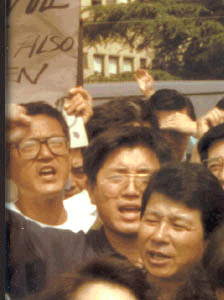

This movie made me cry out of sadness and also, what I recognize looking back on what I felt watching it, as my own guilt. I think the way the Asian American experience tied in to this movie was the way it treated family relationships, and how the notion of family changes or translates when shifted into an American context and a new set of cultural values. It is so easy for the son to completely immerse himself in his white girlfriend’s family because it comes without the stigma of obligation or embarrassment. While I could feel myself frustrated with his character for not appreciating his own family, I recognized this same psychological tendency in myself and that’s what bothered me the most. This is not at all to say that white American families are not as close knit or don’t require as much devotion, but rather that I think the film comments on the faulty reasoning of second generation Asian American children like myself and their willingness to abandon or forget about their cultural roots.
Company Credits (via IMDb.com):
Production Companies / Fox Searchlight Pictures, Cine Mosaic, Entertainment Farm (EF), Mirabai Films, UTV Motion Pictures
Distributors / Fox Searchlight Pictures (2007) (USA) (theatrical)












